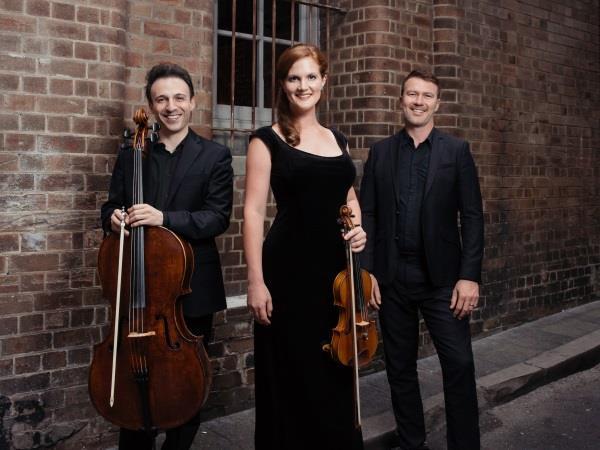Cellist Umberto Clerici, violinist Emma Jardine and pianist Benjamin Kopp. Photo: Daniel Boud.
The eleven-year-young Streeton Trio comprises Emma Jardine (violin), Benjamin Kopp (piano) – both graduates of the Australian National Academy of Music (ANAM) with further training accomplished at the Haute école de musique in Geneva – and Umberto Clerici (cello) who is also the Sydney Symphony Orchestra’s principal cellist.
The work of the ensemble’s famous namesake painter, Australian Impressionist Arthur Streeton, speaks of a sensitive and imaginative vigour with a subtly graded palette. It is a name that seems appropriately applied to this gifted ensemble of chamber musicians which has the potential to be one of the country’s best piano trios. While Emma and Benjamin were undertaking their final studies in Switzerland, they had a dream of moving back to Australia and building a small concert hall attached to their home where they could hold their own concerts. Last year this remarkable project became a reality. Wentworth Falls (elevation 867 metres) is a township approximately 100 kilometres west of Sydney in the Blue Mountains. Here, overlooking a bushland reserve, now sits the new impressive venue with a high timber ceiling and a finely voiced and carefully maintained Steinway & Sons piano. Sunday afternoon’s recital, enjoyed by a capacity audience of 100 or so, was only the second to have taken place in the new hall, with the first given last November. Exciting plans are afoot for a yearly season of concerts.
The program comprised two short works by Schubert, his Sonatensatz (Sonata Movement), D28 composed when he was just 15 and by contrast the Notturno in E flat major, Op 70 No 2 written when he was composer at the peak of creative maturity. The major works were Beethoven’s Piano Trio in E flat major, Op 70 No 2 and the luxuriously Romantic Piano Trio No 1 in D minor, Op 32 by Russian Anton Arensky. In total 81 minutes of challenging chamber music made for a major recital.
Each work was introduced by a member of the ensemble with intelligent, brief information and amusing anecdotes. Schubert’s very young Sonatensatz received a buoyant and good-humoured rendering. Within this peaceful ambience, Beethoven’s lesser known Trio of the Op 70 set began atmospherically with sombre contrapuntal material before the generously phrased Allegro, ma non troppo. The double variation form of the second movement was full of charm and lilt, while the third movement displayed the refinement of Jardine’s technique and a strong and colourful cello line from Clerici. The Finale was all brilliance and ebullience.
As Umberto Clerici then explained, Schubert’s ‘Nocturne’ (a posthumously invented title) may have been intended as a slow movement for the composer’s Piano Trio, D898 with its thematic link to that work. Its slow introduction and soft chords for the piano followed by rhythmically emphatic material was superbly conveyed. As the eucalyptus trees receding behind the performers into the distance were gradually lit from the west by the late-afternoon autumnal glow, the audience settled in for a rich Russian main course.
Recognised more as an important teacher (Rachmaninov being one of his pupils) Anton Arensky is not known for many important compositions, but his dark first piano trio in D minor is an exception. There is not a dull moment in this four-movement, half-hour work. The Streeton’s performance was superb, with highlights being Jardine and Clerici’s warm string tone and sensitive counterpoint and Kopp’s beautifully weighted touch and broad phrasing throughout. If I could point to any adjustments, I would ask for more ‘fire’ in the first extensive movement, for the Scherzo to be more filigree and a notch faster and for a closer ensemble rapport in the Finale.
4 stars out of 5 ★★★★
The Streeton Trio – Beethoven, Schubert and Arensky
9 June 2019
Wentworth Falls NSW





